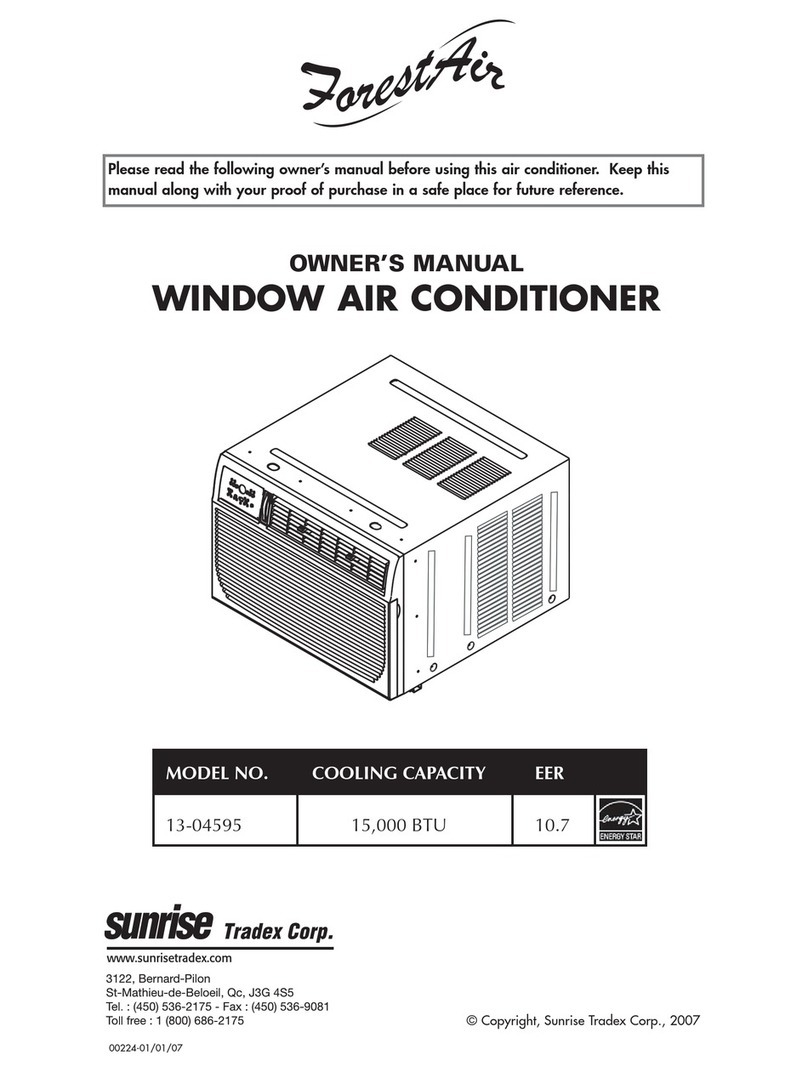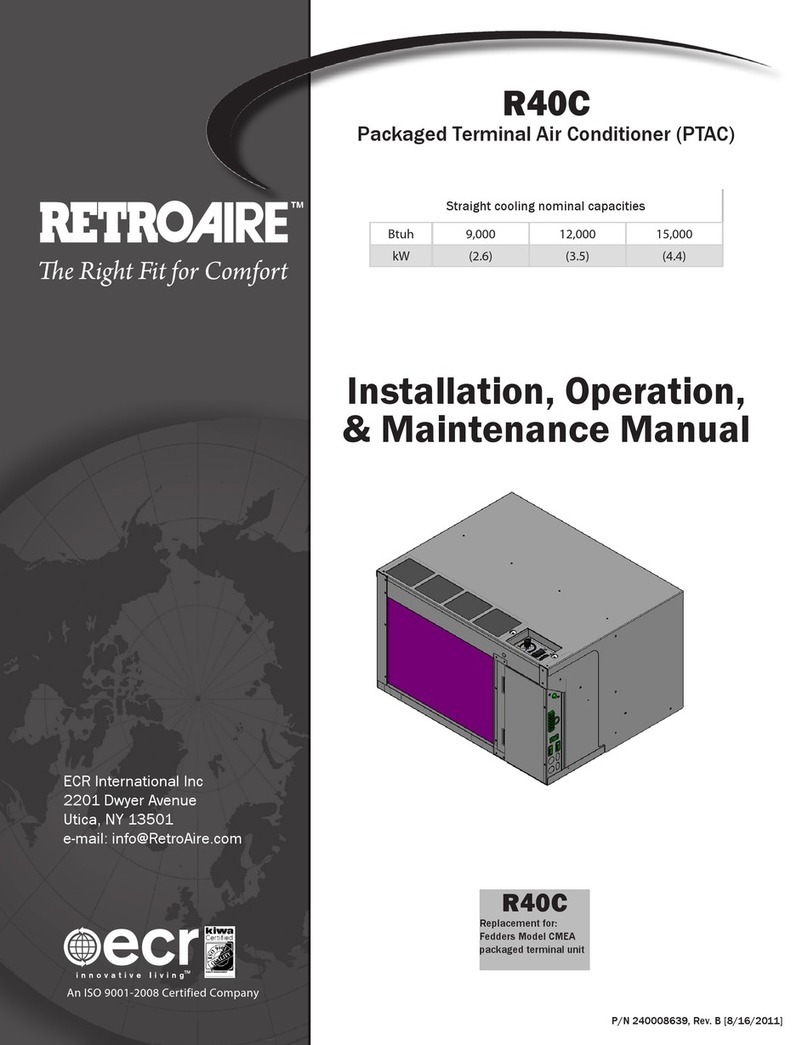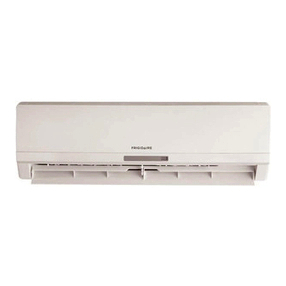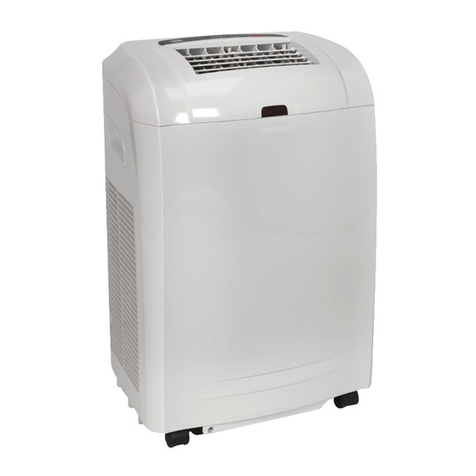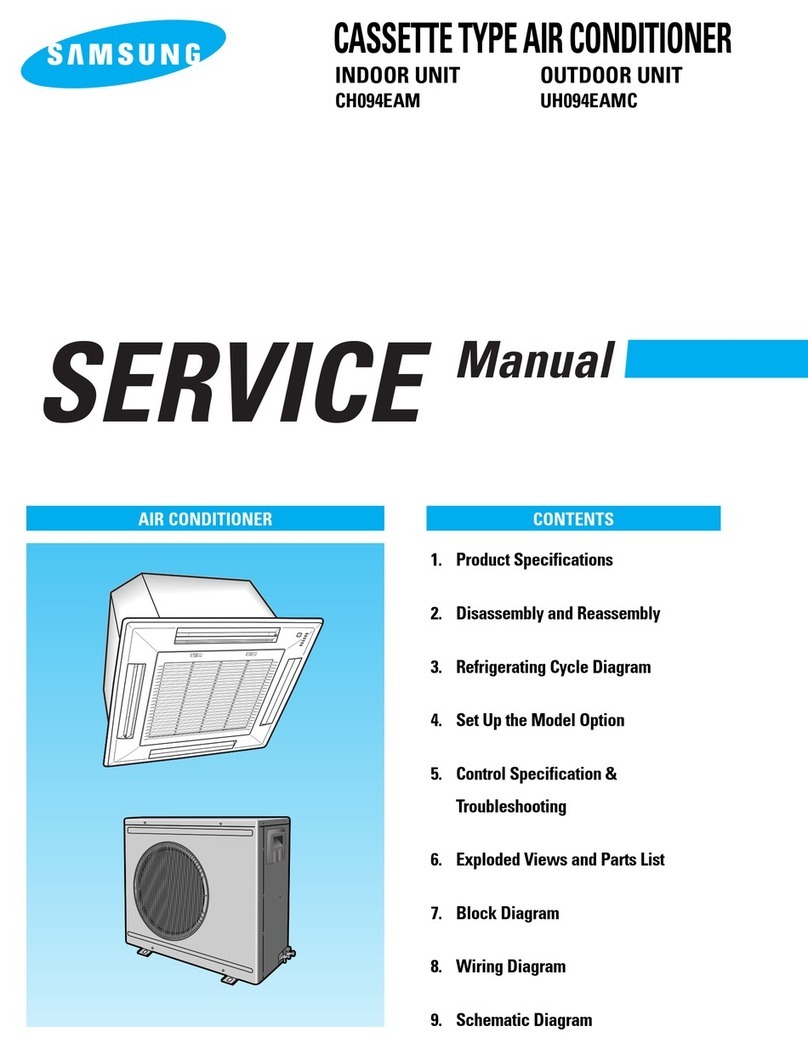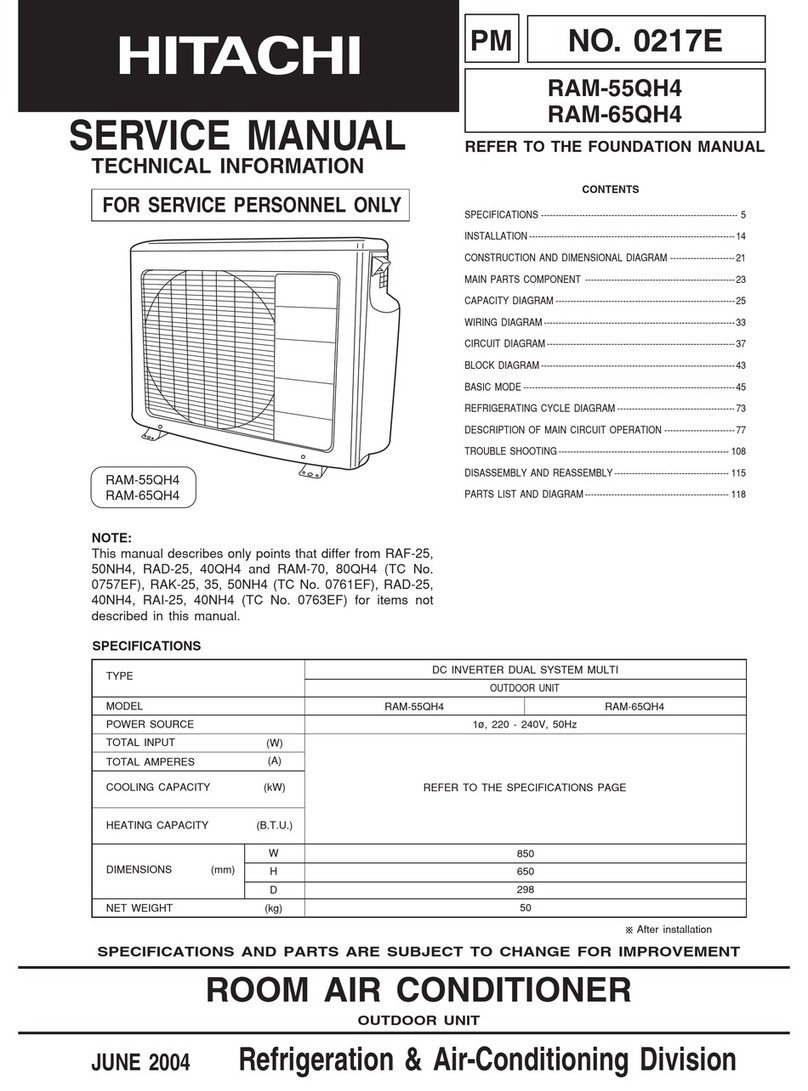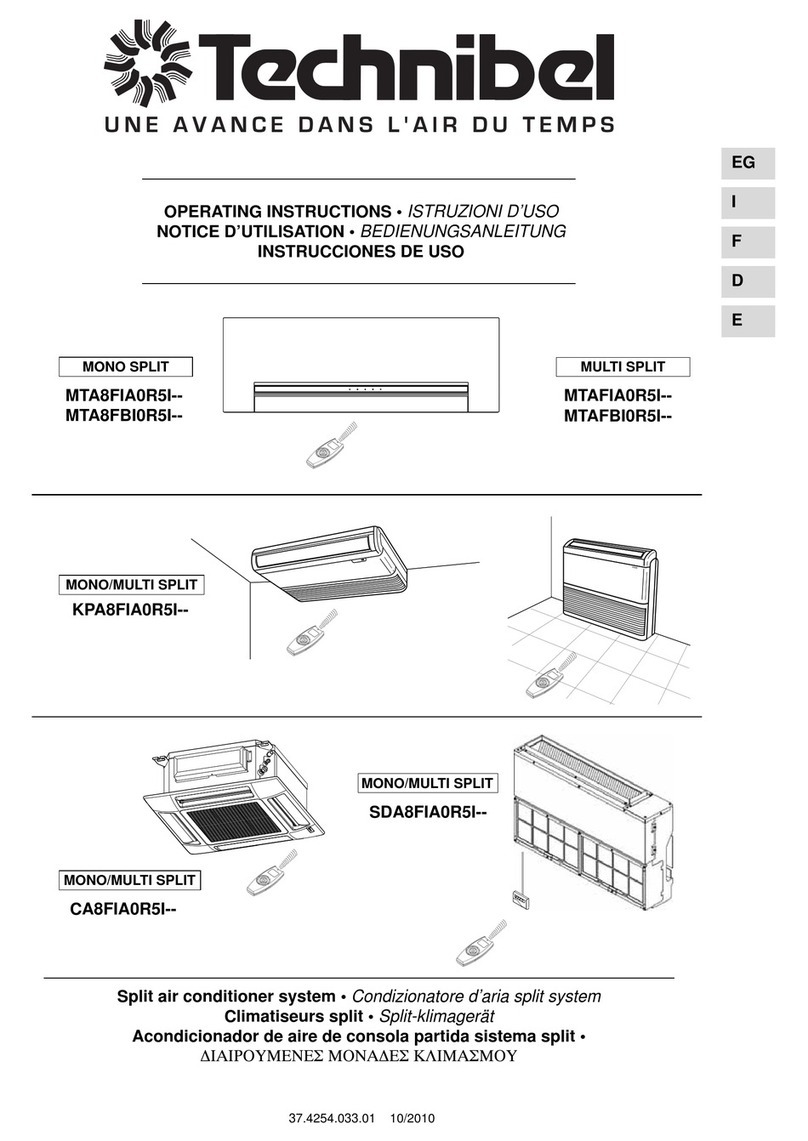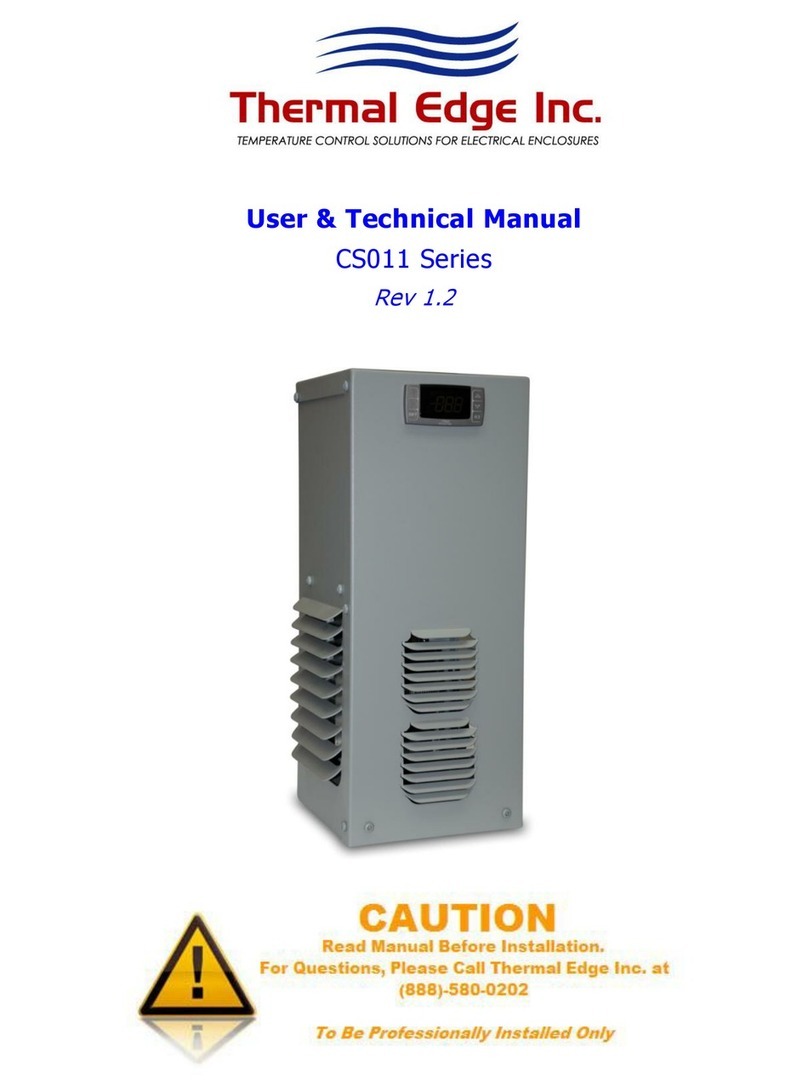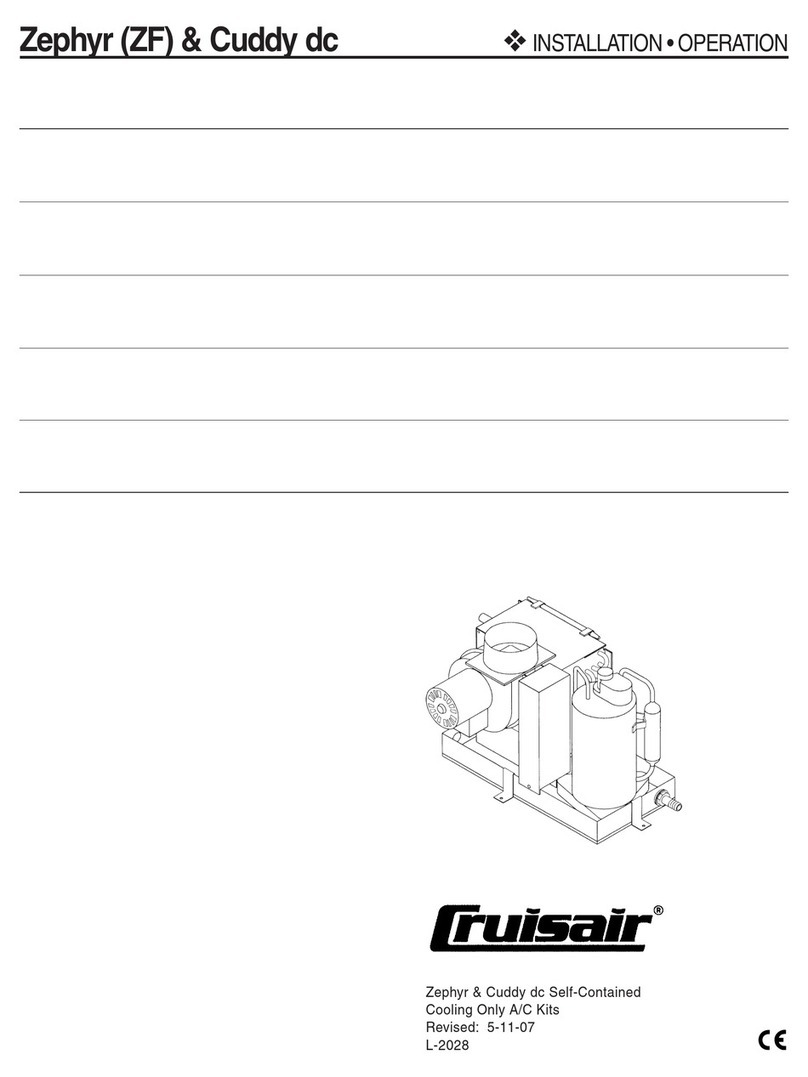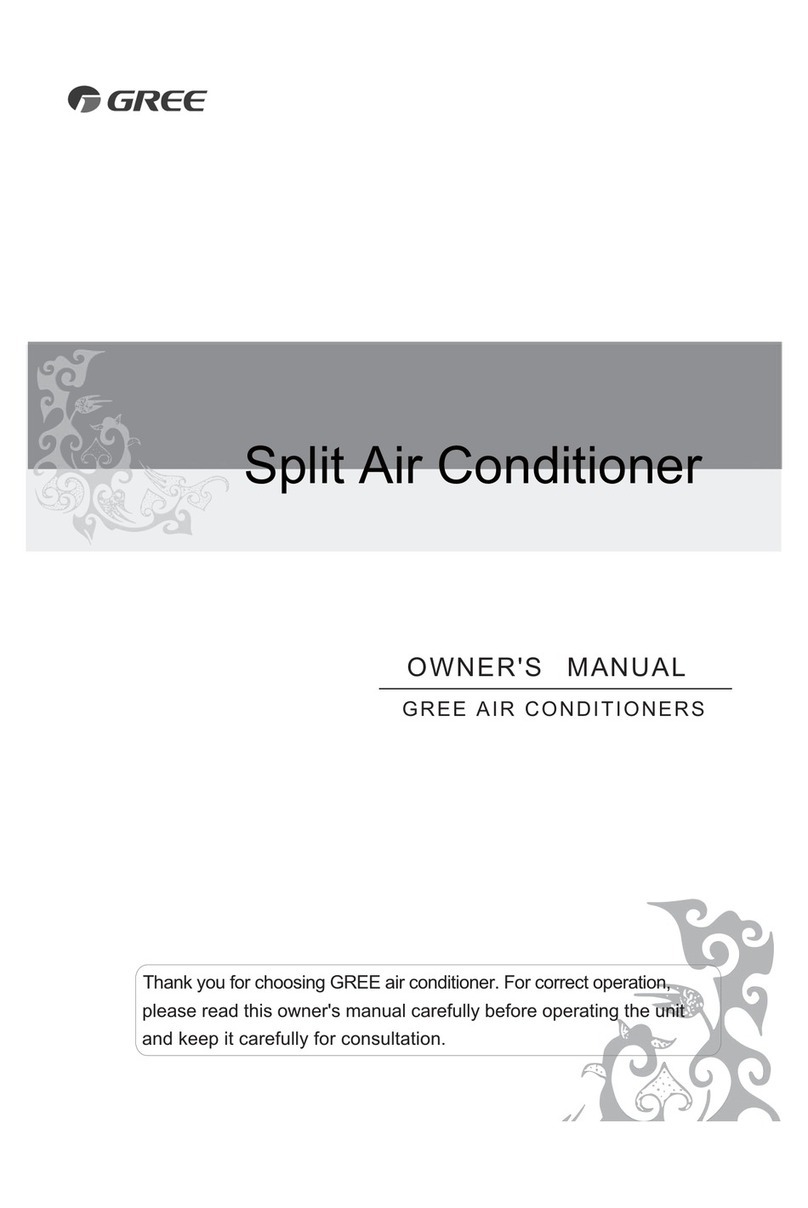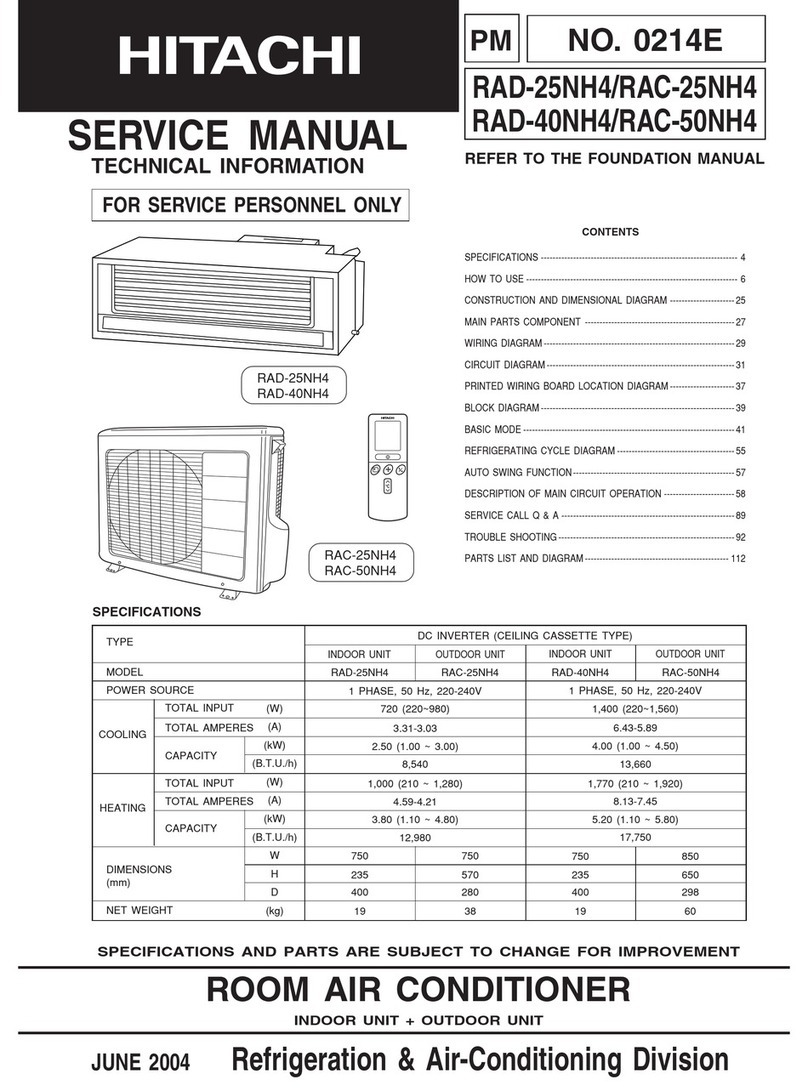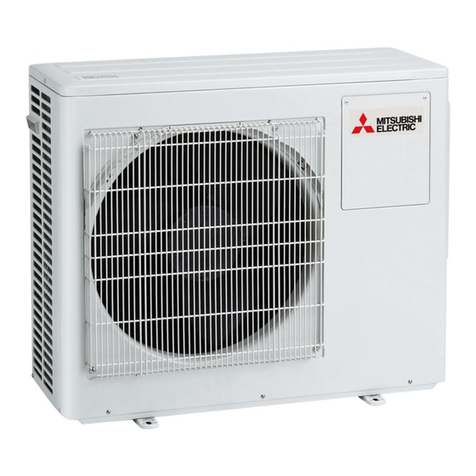ForestAir A019-08KR User manual

FA-UM-PAC-5693 - v1.0 - 12/2018 © Copyright, ForestAir, 2018
IMPORTANT : Please read this manual carefully before running this unit, and save it for future reference.
OWNER’S MANUAL
PORTABLE AIR CONDITIONER
A019-08KR


3
Air conditioners, heat pumps and dehumidiers are pieces of high value. ln order to ensure your lawful
rights and interests, if you are not familiar with the installation of this type of appliance, please have a
professional technician do the installation for you. This instruction manual is the universal-purpose version
for this model manufactured by ForestAir. The appearance of the unit that you have purchased may differ
from the ones seen in this manual, however it does not change the basic instructions on how to operate
and use the appliance.
To ensure satisfactory operation for many years to come, this manual should be read carefully before
using the product. After reading, store in a safe place. Please refer to the manual for questions on use or
in the event that any irregularities occur.
1.0. SAFETY INSTRUCTIONS ........................................................................................................................4
2.0. COMPONENTS ........................................................................................................................................5
3.0. INSTALLATION GUIDE
3.1. Assembling the exhaust hose ................................................................................................................6
3.2. Assembling and installing the window kit ..............................................................................................7
3.3. Connecting the exhaust hose to the window kit....................................................................................8
4.0. OPERATION GUIDE
4.1. Control panel and remote control overview ........................................................................................10
4.2. Button functions ...................................................................................................................................12
4.3. Remote control operation ....................................................................................................................13
4.4. Other functions .....................................................................................................................................13
4.5. Water drainage .....................................................................................................................................14
5.0. CARE & MAINTENANCE
5.1. Cleaning the surface ............................................................................................................................15
5.2. Cleaning the air lter ............................................................................................................................15
5.3. Postseason storage .............................................................................................................................15
6.0. TROUBLESHOOTING ............................................................................................................................16
7.0. WARRANTY .............................................................................................................................................17
TABLE OF CONTENT
FOREWORD
Electrical products should be properly disposed.
Please recycle where facilities exist.
Check with your local authority or retailer for recycling.

4
Read the following safety instructions before installing the unit or doing service work.
To reduce the risk of re, electric shock, or personal injury when using this appliance, follow these basic
safety precautions.
PRECAUTIONS
▪ The air conditioner is only suitable for indoor use, no other applications.
▪ Follow local grid interconnection rules while installing the air conditioner and ensure that it is
properly grounded. If you have any question on electrical installation, follow the instructions of the
manufacturer, and if necessary, ask a professional electrician to install it.
▪ Place the unit on a at surface and in a dry area. Keep a clearance of at least 50 cm (20 in) around
the appliance and the surrounding objects or walls.
▪ After the air conditioner is installed, ensure that the power plug is intact and rmly inserted into the
electric outlet. Arrange the power cord so that no one accidentally trips over it or pulls it out of the
outlet.
▪ Do not put any object into the air inlet or outlet of the air conditioner. Keep the air inlet and outlet
free from obstructions.
▪ When installing the drainage hose, ensure that it is properly connected and not twisted or bent.
▪ While adjusting the horizontal and vertical shutters of the air outlet, handle gently to avoid
damaging any parts.
▪ When moving the appliance, make sure that it is in an upright position.
▪ Keep the appliance away from gasoline, ammable gas, stoves and other heat sources.
▪ Do not disassemble, overhaul or modify the air conditioner arbitrarily, it could cause a malfunction
or even personal injury and material damage. To avoid danger, if a failure occurs, ask the
manufacturer or professionals to repair it.
▪ Do not install and use the air conditioner in the bathroom or other humid environments.
▪ Do not pull the plug as a mean to turn the appliance off.
▪ Do not place any liquid containers on top of the unit to prevent water or other liquids from spilling
into the air conditioner.
▪ Do not use insecticide sprays or other ammable substances near the air conditioner.
▪ Do not wipe or wash the air conditioner with chemical solvents such as gasoline or alcohol. When
cleaning the appliance, make sure to disconnect the power supply, then clean the surface with a
soft damp cloth. If the unit is really dirty, scrub with a mild detergent.
▪ This appliance is not intended for use by persons (including children) with reduced physical,
sensory or mental capabilities, or lack of experience and knowledge, unless they have been given
supervision or instruction concerning use of the appliance by a person responsible for their safety.
Children should be supervised to ensure that they do not play with the appliance.
WARNING : Can cause serious personal injury or death.
CAUTION : Can lead to injury or structural damage under some conditions.
1.0. SAFETY INSTRUCTIONS

5
2.0. COMPONENTS
FRONT VIEW
8
7
5
10
REAR VIEW
1
2
3
4
9
6
Extendable
exhaust hose
Window adapter Hose connector Remote control
Wing nut and bolt
Type A screw (2)
Grill
1 Control panel 5 Air lter 9 Exhaust vent
2 Air outlet / Shutters 6 Continuous drain nozzle
10
Power cord and plug
3 Handle 7Drain port
4Castor 8 Rubber plug and drain cap
Window slider kit (2 panels)

6
3.0. INSTALLATION GUIDE
Caution : Before using the air conditioner, make sure
it has been in an upright position for at least two hours.
Position the air conditioner near a window, on a level
surface, in the upright position. For best performance,
leave at least 50 cm (20 in) of clearance all around the
unit to allow good airow (see Figure 1). Do not install
and use the appliance in a bathroom or other humid
environments.
█ 3.1. ASSEMBLING THE EXHAUST HOSE
1) Screw on the window adapter unto the extendable hose on one end, and the hose connector on
the other (as show in Figure 2). Ensure proper t on both ends. The supplied exhaust hose can be
extended to a maximum of 150 cm (59 in).
2) Align the hose connector with the exhaust vent, then push the connector on the slide rails all the way
to the left until it snaps into place (as shown in Figure 3). Keep the exhaust hose assembly horizontal
to avoid getting stuck.
5-10 cm (2-4 in)
Stretch both ends of the exhaust hose for 10 to 15 cm (4 to 6in)
5-10 cm (2-4 in)
FIG. 2
FIG. 3
Slide to snap
into place
FIG. 1
Min. 50 cm (20 in)
Min. 50 cm (20 in)

7
3.0. INSTALLATION GUIDE
█ 3.2. ASSEMBLING AND INSTALLING THE WINDOW KIT
Your window kit has been designed to t most standard vertical and horizontal window applications,
however it may be necessary for you to improvise or modify some aspect of the installation procedures
for certain types of window. Adjust the panels to the desired length and use provided metal wing nuts
and bolts to secure (see table for minimum and maximum window openings).
MAXIMUM : 130 cm (51 in)
MINIMUM : 23 cm (9 in)
Panel
Window length A B
23-65 cm (9-25 in) ●
46-130 cm (26-51 in) ● ●
Notes :
▪ If the window opening is less than 65 cm (25 in), the minimum length of the panel A, shorten the panel
by cutting off the exceeding length in order to t the window opening.
▪ Never cut out the hole from panel A.
A : 65 cm (25 in)
B : 65 cm (25 in)
FIG. 4 – For a 23-65 cm (9-25in) window opening
Panel A
Panel A
23-65 cm (9-25 in)
23-65 cm (9-25 in)
Panel A
Panel B
Panel B
66-96 cm (26-38 in)
66-96 cm (26-51 in)
FIG. 5 – For a 66-130 cm (26-51 in) window opening
Panel A

8
3.0. INSTALLATION GUIDE
█ 3.3. CONNECTING THE EXHAUST HOSE TO THE WINDOW KIT
Extend the exhaust hose, connect the end with the window adapter to the window kit then nally attach
the grill to prevent large insects and small animals from entering (as shown in Figure 7, 8 and 9).
Note : There may be poor sealing due to
gaps left by some non-standard windows.
Please purchase appropriate foam
weatherstripping (not included) in order to
enhance the cooling efciency of the air
conditioner.
FIG. 8 – Slide to lock
Insert
Slide
FIG. 9 – Fix the grill to the adapter with screws
FIG. 6 – Add foam weatherstripping
FIG. 7 – Connect to window panel A
Panel A
Type A screws

9
3.0. INSTALLATION GUIDE
Caution :
▪ The length of the exhaust hose is specially designed for the unit. Do not replace by any other hose, or
connect to an another one, as this this may cause malfunction.
▪ The exhaust hose should be free of any obstructions.
▪ An exhaust hose with sharp angles and bents will prevent the air from being evacuated properly
which could cause the unit to malfunction or shut-off.
NOT RECOMMENDED RECOMMENDED

10
4.0. OPERATION GUIDE
█ 4.1. CONTROL PANEL AND REMOTE CONTROL OVERVIEW
CONTROL PANEL INDICATORS
CONTROL PANEL KEYS
TIMER
SETTING
FAN SPEED
SELECTION
UP DOWN MODE
SELECTION
POWER
ON / OFF
MODE
RESERVOIR FULL
TEMPERATURE / TIME LCD DISPLAY
POWER ON / OFF
SLEEP MODE
TIMER
TEMPERATURE UNIT (°C / °F)

11
4.0. OPERATION GUIDE
REMOTE CONTROL KEYS
POWER ON / OFF
MODE SELECTION
TIMER SETTING
UP
FAN SPEED SELECTION
DOWN
SLEEP MODE

12
4.0. OPERATION GUIDE
█ 4.2. BUTTON FUNCTIONS
Note : Operation of functions is the same when using remote or control panel, unless otherwise stated.
POWER ON / OFF
Press this button to turn the unit ON or OFF. When rst powered on, the unit will
emit a ringing tone and go into standby mode. The display screen will show the
current temperature.
MODE SELECTION
While the unit is running, press this button to switch between operation mode :
Cooling ( ), Dehumidication ( ) and Ventilation ( ).
UP / DOWN
Press these keys to change the set Temperature or Timer value as follows :
▪ When setting a temperature, use UP or DOWN to increase or decrease the
desired temperature (not available in Ventilation or Dehumidication mode). The
temperature can be set between 16 – 31°C (61 – 88°F).
▪ When setting a timer, use the UP or DOWN buttons to increase or decrease the
desired time value.
FAN SPEED SELECTION
In Cooling and Ventilation mode, press this key to select a ventilation speed : High,
Medium or Low.
In Dehumidication mode, the ventilation speed is automatically set to Low and
cannot be changed.
TIMER SETTING
While the unit is running, press this button to set a switch-OFF timer. While the unit
is turned off, press this button to set a switch-ON timer.
When the Timer symbol ( ) begins ashing, use the UP and DOWN buttons to
select the desired time value.
The timer can be set within 1 to 24 hours and is adjusted by increments of one hour.
The timer can be cancelled by setting the time value to “00” or by powering off.
CONTROL
PANEL
REMOTE
CONTROL
SIMULTANEOUSLY
WITH
SIMULTANEOUSLY
WITH
SIMULTANEOUSLY
WITH
SLEEP MODE
While in Cooling mode, press this button to turn on Sleep mode. The unit will
switch to energy-saving and quiet mode.
Note : Sleep mode cannot be activated in Ventilation or Dehumidication mode.
TEMPERATURE UNIT SELECTION
Press these keys to switch between Celsius (°C) and Fahrenheit (°F).
AND / OR AND / OR

13
4.0. OPERATION GUIDE
█ 4.3. REMOTE CONTROL OPERATION
▪ Inserting Batteries in the Remote Control
1) Press and slide down the battery compartment cover (located on the back of the remote) to remove it.
2) Insert two new R03 “AAA” 1.5 V batteries into the battery compartment. Be sure to match the
polarities correctly.
3) Replace the cover.
Caution :
▪ Do not mix old and new batteries. Do not mix alkaline, standard (carbon-zinc) or rechargeable
batteries.
▪ If the remote control is not be used for a certain length of time, remove the batteries (batteries may
leak or explode).
▪ If the remote control unit is replaced or discarded, the batteries must be removed and disposed of in
accordance with current legislation as they are harmful to the environment.
▪ Operating the Remote Control
Point the remote control to the air conditioner and press the
desired keys. The remote control must be no more than 5 m
(16 ft) away from the appliance (without obstacles between
the remote control and the appliance).
Caution :
The remote control must be handled with care. Do
not drop or expose it to direct sources of heat, sunlight or water.
█ 4.4. OTHER FUNCTIONS
FROST PROTECTION
In a cold environment, if the temperature of the exhaust hose drops too low, the appliance automatically
enters a protection mode to ensure the unit is not damaged. When the temperature of the hose rises to a
warmer level (10°C / 50°F), the unit automatically reverts back to normal operation.
OVERFLOW PROTECTION
When the reservoir becomes full, the unit will emit a beep and the overow indicator Full on the display
screen of the control panel will light up. At this point, you need to drain the accumulated water (for
details, see section 4.5. Water Drainage of this manual). After the water is drained, the unit resumes
normal operation.
COMPRESSOR PROTECTION
To increase the service life of the compressor, it has a 3-minute delay booting protection function after
the compressor is turned off.
MAXIMUM 5 M (16 FT)

14
4.0. OPERATION GUIDE
█ 4.5. WATER DRAINAGE
▪ Manual Drainage
This ForestAir portable air conditioner has a self-evaporative system. The condensed water will be
recycled to the compressor and evaporator, so most of the water will be dissipated. This method not
only improves cooling efciency but also saves energy.
Since most of the condensed water will be used by the compressor, in general use, there will be no
need to drain the water. However, if you are using the air conditioner for cooling or dehumidifying in
a high humidity location, the collected excess water will need to be drained through the drainage port
at the bottom of the unit. With a full reservoir, the compressor will stop working. Follow these steps to
remove the water :
1) Turn the appliance off and unplug the power cord.
Note : Please move the appliance carefully so as not to
spill the water contained in the reservoir.
2)
Place a container under the drain port located on the back of
the unit. Unscrew the drain cap and remove the rubber plug.
Notes :
▪ Keep the cap and plug at arm’s reach.
▪ The appliance can be tilted slightly backwards to help
with drainage.
▪ If it does not look like the container can hold all the
water, insert the rubber plug into the drain port as soon
as possible to prevent water from overowing. Empty
the container than resume drainage.
3) Once the reservoir is fully drained, replace the rubber
plug and drain cap.
Note : Do not run the appliance without the plug and
drain cap in place, otherwise the condensed water will
drip to the oor or carpet.
▪ Continuous Drainage
You may nd it more convenient to install a drainage hose (not supplied) to allow for continuous
drainage (only possible in Cooling or Dehumidifying mode). To do so, follow these steps :
1) Turn the appliance off and unplug the power cord.
2) Unscrew the drain cap covering the continuous drain
nozzle.
3) Insert the drainage hose into the drain nozzle.
4) Take the hose to a oor drain or container.
5) Replug the power cord and turn the power back on.
Take the hose to
a oor drain or
container
FIG. 12 – Continuous drainage
Place a container
under the drain port
FIG. 11 – Manual drainage
Drain cap
Rubber plug
Drain port
FIG. 10 – Removing drain plugs

15
5.0. CARE AND MAINTENANCE
Caution : Make sure the power is off and the power plug removed from the electric outlet before
performing any maintenance on the unit.
█ 5.1. CLEANING THE SURFACE
Clean the casing with a damp cloth and dry with a soft towel. Avoid using harsh cleaning products
or abrasives such as benzene, alcohol, gasoline and the likes. Such products can cause premature
deterioration and/or yellowing of the surface nish of the air conditioner.
█ 5.2. CLEANING THE AIR FILTER
Clean the air lter once every two weeks in order to prevent dust from
clogging the appliance and reducing its effectiveness.
1) Using a Phillips head screwdriver, unscrew the air lter from the back of
the unit (as shown in Figure 13).
2) Soak the lter into warm water (about 40°C / 104°F) with a neutral
detergent. If it is very dirty, use a vacuum cleaner to remove dust
accumulations from the lter. Immerse in warm water and rinse
multiple times.
3) Let dry after rinsing thoroughly before reinserting into the appliance.
Caution : Never operate the appliance without the air lter.
█ 5.3. POSTSEASON STORAGE
1) Remove any excess water out of the reservoir.
2) Clean the lter and dry thoroughly before putting back.
3) Turn the unit on, select Fan mode and adjust to Low ventilation speed. Allow the unit to operate in
this condition for a period of time in order to dry the drain pipe and inside of the appliance from any
moisture to prevent the growth of mildew. Once this is done, replace the water plug and drain cap.
4) Turn the unit off and unplug the power cord from the electric outlet.
5) Remove the exhaust hose.
6) Remove the batteries from the remote control.
7) Cover the air conditioner and all its components with a plastic bag. Store the appliance in a cool, dry
place, away from direct sunlight, extreme temperatures, and excessive dust. Keep out of children's
reach.
FIG. 13 – Removing the lter
Screw

16
6.0. TROUBLESHOOTING
Before you call for service, review the following list. It may save you time and expense. This list
includes common occurrences that are not the result of a defect in workmanship or materials.
SITUATION POSSIBLE CAUSES SOLUTIONS
The air conditioner
does not work.
There is no electricity. Turn it on after connecting the unit to a socket
with power, or if there is a power outage, wait for
electricity to be restored.
The overow indicator Full is on. Drain the water from the unit.
The ambient temperature is too low or
too high.
The recommended working temperature for this unit
is 7 to 35°C (44 to 95°F).
In Cooling mode, the room temperature
is lower than the set temperature.
This is normal. Leave the temperature as it is, or
if a colder environment is desired, lower the set
temperature so that it is below the room temperature.
In Dehumidication mode, the ambient
temperature is low.
The appliance must be placed in a room with an
ambient temperature greater than 17°C (62°F).
The cooling efciency
of the unit is very
poor.
There is direct sunlight in the room. Pull the curtain or close the blinds to prevent
sunlight from heating the room.
Doors or windows are opened. Close doors and windows.
There are a lot of people in the room. Wait for people to leave to see if the room cools
down.
In Cooling mode, there are other
sources of heat present in the room.
Turn off or remove any heat sources that could be
counteracting the cooling efciency of the unit.
The lter is dirty. Clean or replace the air lter.
The air inlet and/or outlet is obstructed. Clear objects or furniture that could be blocking the
inlet and/or outlet of the unit.
There is noise
coming from the unit.
The air conditioner is not placed on a
at surface.
To reduce noise and vibration, put the air conditioner
on a at and hard surface.
The compressor
does not work.
The unit was recently turned off. Wait for the 3-minute protection delay to end then
restart the appliance.
The remote control
does not work.
The distance between the appliance
and the remote control is too far.
Get closer to the unit so the remote control signal
can reach the unit's signal receiver.
The remote control is not properly
aligned with the portable unit signal
receiver.
Make sure to be facing the unit when pressing keys
on the remote control.
The batteries are dead. Replace with new batteries.
If problems not listed in the table occur or recommended solutions do not work, please contact after-
sales service for assistance.

17
█ LIMITED WARRANTY
This air conditioner is covered by a warranty against defects in materials and workmanship, if used
for the applications specied in this manual, for a period of ONE (1) year from the date of original
purchase in Canada.
During the warranty period, if the dehumidier fails under normal use, ForestAir will, at its option, either
repair the unit or replace it, free of charge, within a reasonable period of time after the air conditioner is
returned.
As a condition to any warranty service obligation, the customer must present this warranty certicate
along with the proof of purchase.
█ THIS WARRANTY DOES NOT COVER…
▪ Damage, accidental or otherwise, to the appliance that is not caused by materials or workmanship
defect.
▪ Damage caused by misuse, tampering or failure to follow the operating and maintenance instructions
provided in this manual.
▪ Damage to the nish of the unit enclosure or to other outer features caused by wear.
▪ The lters.
▪ Damage caused by repairs or modications to the appliance made by any person not duly authorized by
ForestAir.
▪ Insurance and freight costs for the warranty service.
ALL IMPLIED WARRANTIES, INCLUDING ANY IMPLIED WARRANTY OF MERCHANTABILITY,
ARE LIMITED TO A ONE (1) YEAR PERIOD COVERED BY THIS EXPRESS LIMITED WARRANTY.
FORESTAIR DISCLAIMS ANY LIABILITY FOR CONSEQUENTIAL OR INCIDENTAL DAMAGES AND,
IN NO EVENT SHALL FORESTAIR LIABILITY EXCEED THE RETAIL VALUE OF THE APPLIANCE
FOR BREACH OF ANY WRITTEN OR IMPLIED WARRANTY WITH RESPECT TO THIS AIR
CONDITIONER.
Keep this manual along with your proof of purchase in a safe place for future reference. You
must provide proof of purchase for warranty service.
Enter the following information about your air conditioner ; it will help you upon getting assistance or
service, if you ever need it. You will have to provide the model and serial numbers of the air conditioner.
These informations are detailed on the rating plate of the unit.
Dealer name : ____________________________________________________________________
Address : ________________________________________________________________________
Model number : ___________________________________________________________________
Serial number :____________________________________________________________________
Date of purchase : _________________________________________________________________
7.0. WARRANTY

Table of contents
Other ForestAir Air Conditioner manuals
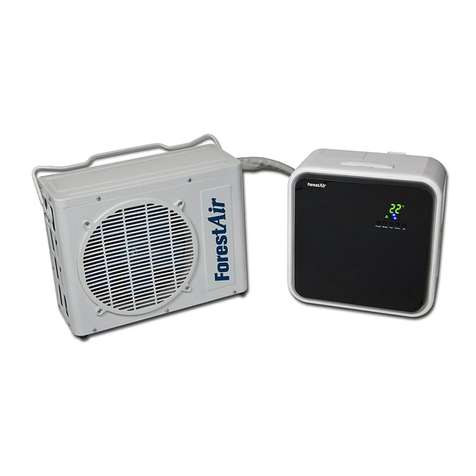
ForestAir
ForestAir F001-MP8K User manual
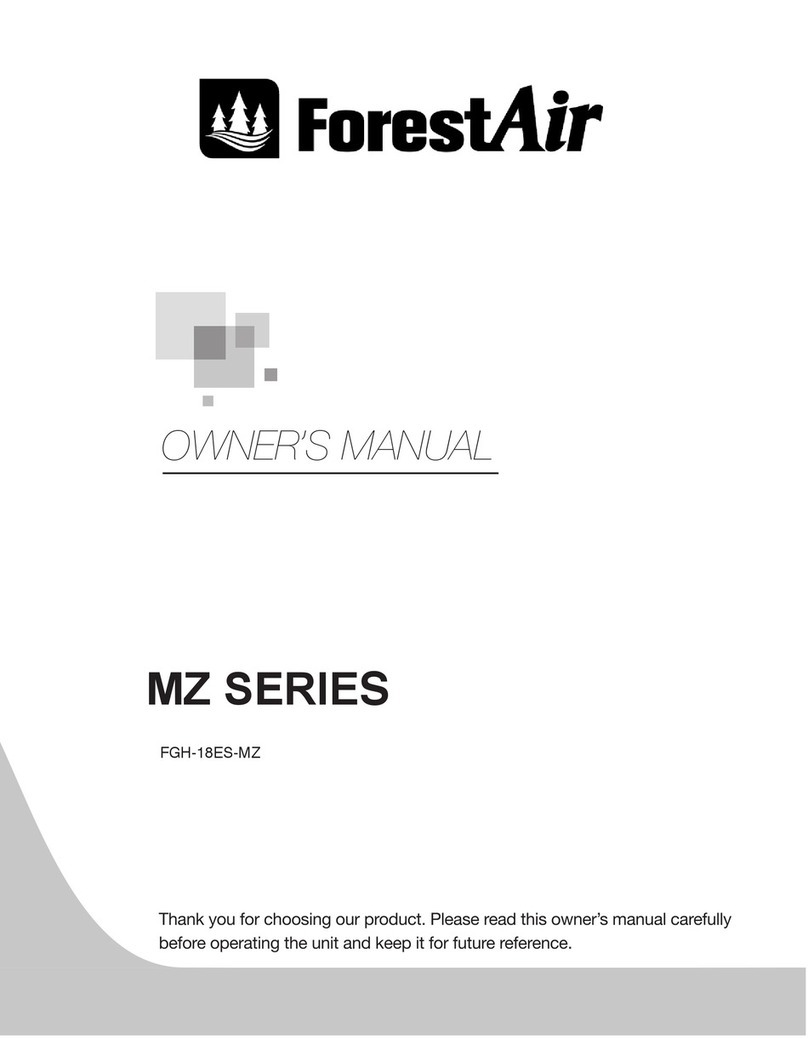
ForestAir
ForestAir MZ Series User manual

ForestAir
ForestAir 13-04543 User manual
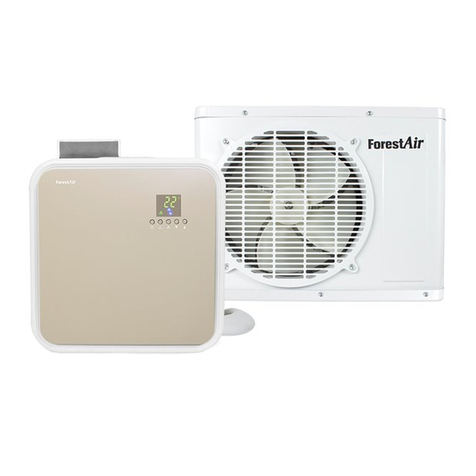
ForestAir
ForestAir F001-MP8K-B User manual
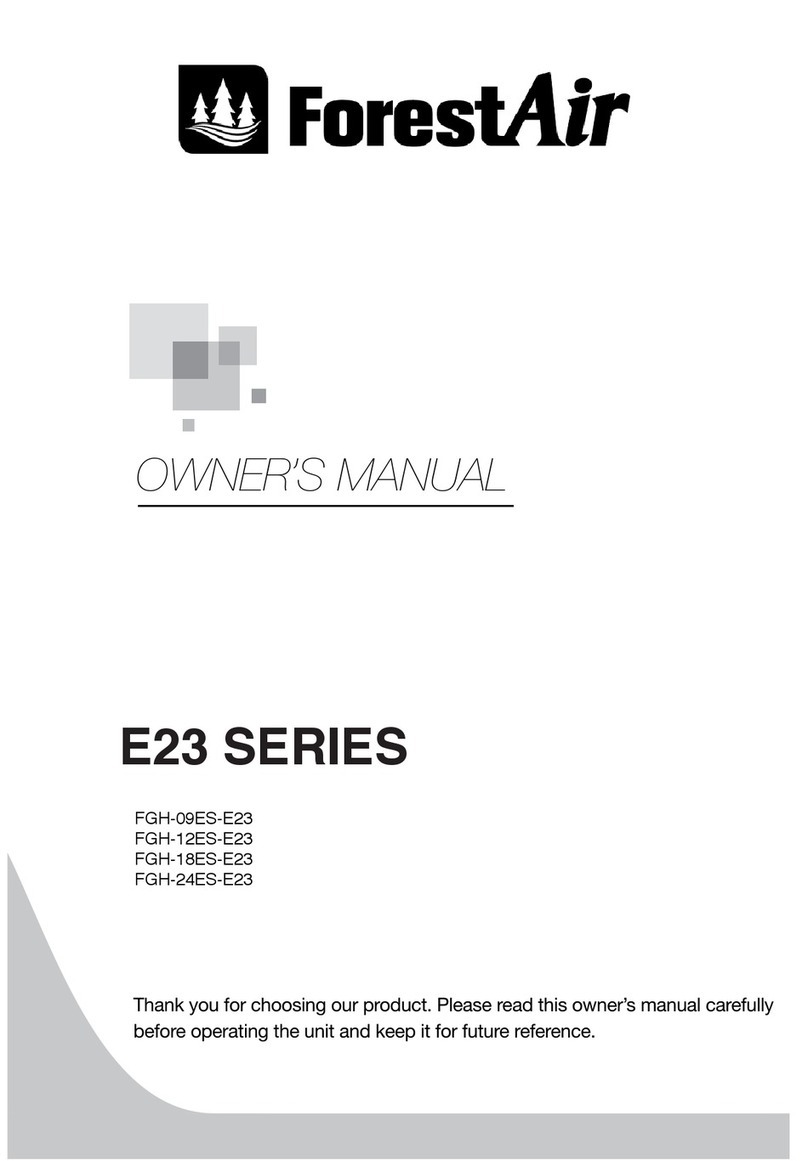
ForestAir
ForestAir E23 Series User manual
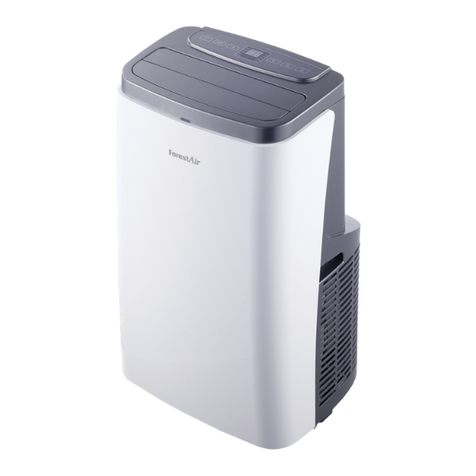
ForestAir
ForestAir FA-10PA User manual
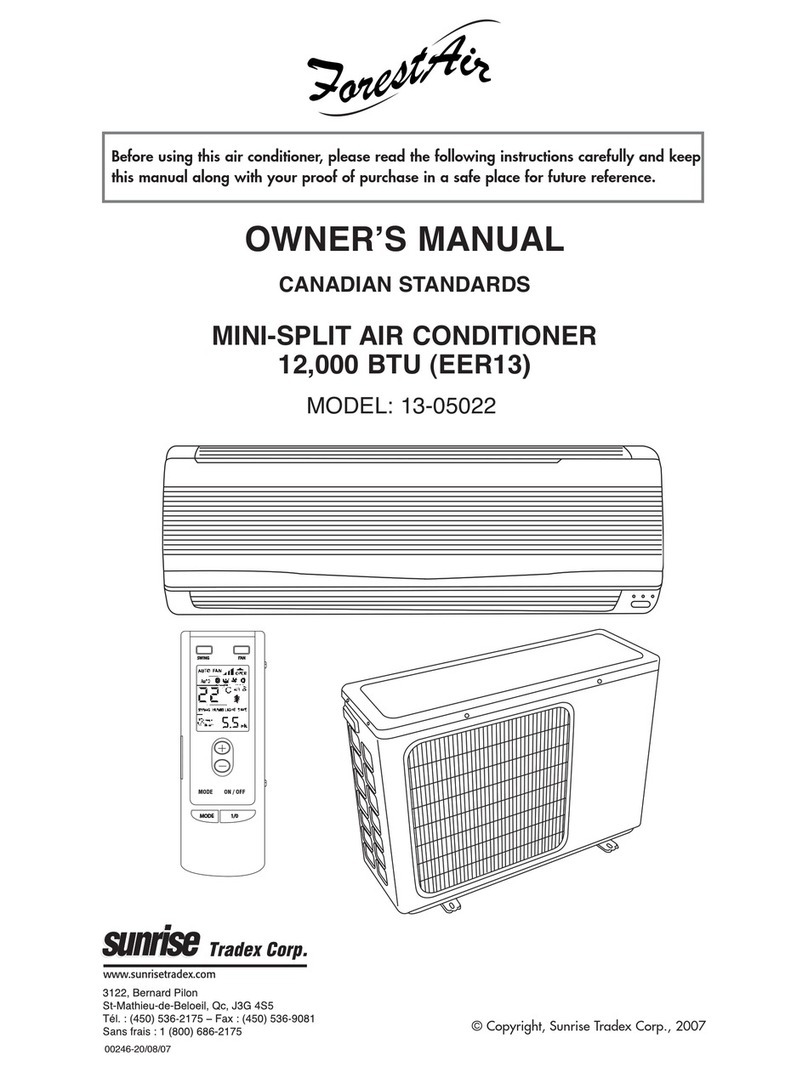
ForestAir
ForestAir 13-05022 User manual
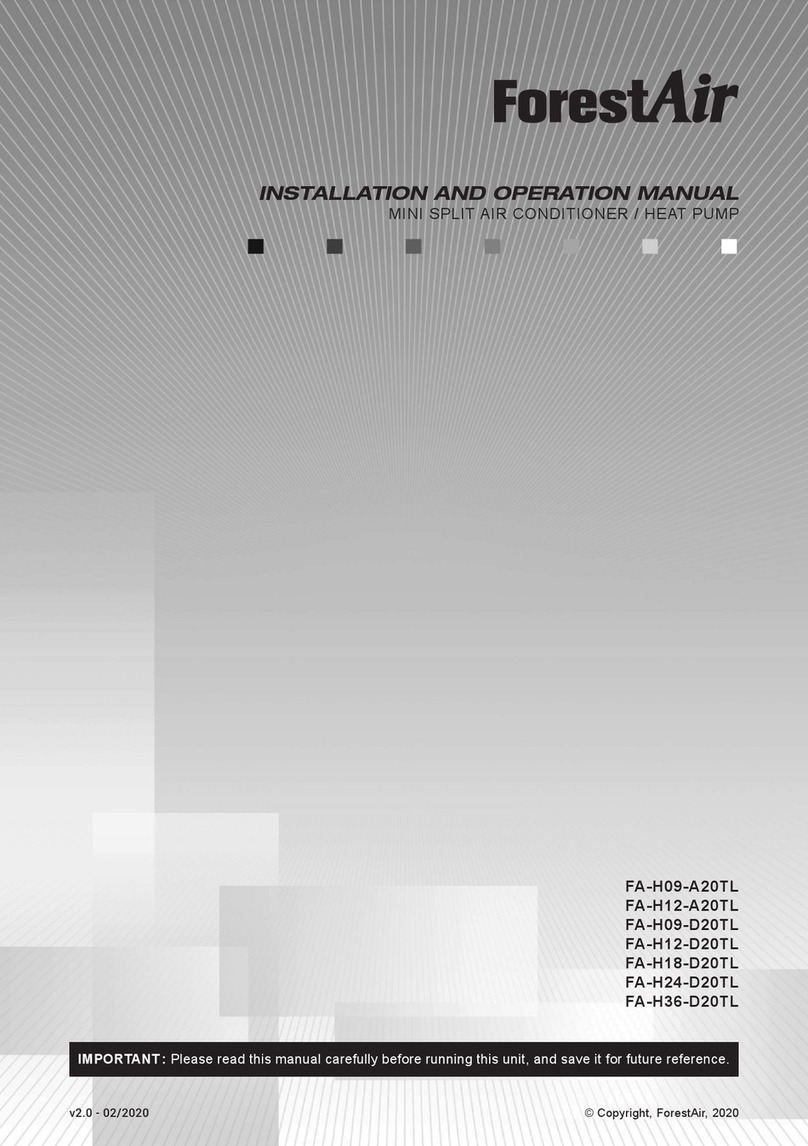
ForestAir
ForestAir FA-H09-A20TL User manual

ForestAir
ForestAir 13-04596 User manual
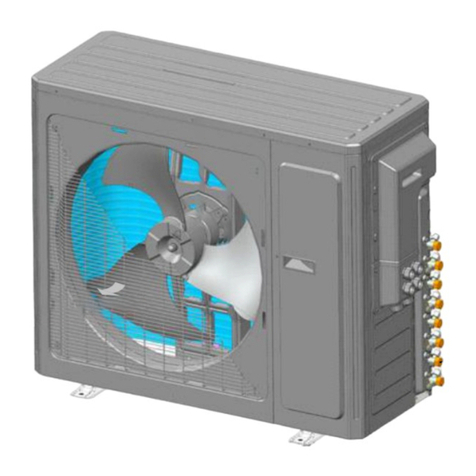
ForestAir
ForestAir FGH-42ES-MZ User manual
